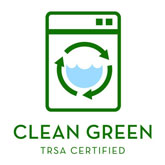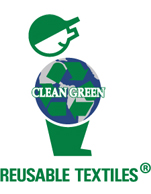Prudential Overall Supply: ‘Do the Right Thing’
Prudential Overall Supply (POS) was getting plenty of promotional mileage out of the industry’s green attributes long before TRSA began certifying textile services companies "Clean Green" in 2012. For example, commemorating the 40th anniversary of Earth Day in 2010, an issue of the quarterly company magazine was dedicated to industry-wide and POS-specific improvements in conservation and discharge control. By that time, POS had already published two issues of the magazine (known as “Off the Cuff”) dedicated to its operations’ eco-friendliness (1992 and 1999).

Thanks to TRSA’s LaundryESP program, POS had been benchmarking its water and energy use against the industry as a whole and claiming above-average performance in minimizing its carbon footprint. At the same time, the company was touting fundamental green advantages of industrial laundry versus disposables (promoting reusable napkins and shop towels) and home-washing or on-premises laundries (uniforms).
WHY CERTIFY?
There was plenty to say: customers and prospects were getting the message that POS was a green choice. So why certify?
“We felt what we were doing was great, but we wanted a third-party source, an independent body, to put its stamp of approval on our best management practices,” recalls Jerry Martin, sales and marketing VP. “We didn’t have any benchmark or outside authority to indicate that our techniques were the right ones.”
In June 2012, POS received that additional credibility, becoming the first multi-location laundry operation dedicated to industrial markets to earn the TRSA Clean Green certification. At the time, 19 companies, mostly independents with a few locations (at most), were certified. With 27 locations, POS was the largest among them.
Today, Clean Green is about to hit the 50-company mark, accounting for 150 total locations, many of which are Prudential’s competitors. That’s OK with POS.
Martin had been involved in Clean Green’s genesis (TRSA Marketing/PR Committee) and development. At first, he recalls, it was strictly conceptual, envisioned as a campaign or logo that would “do a better job marketing the benefits of reusable textiles.” The committee handed the creative launch of the concept to Pepperdine University (Los Angeles) MBA students, who evaluated it as a class project, suggesting several alternatives for its manifestation, including certifying launderers.
“In Prudential’s mind, from that point forward, it was time for the industry to come around to the idea,” Martin says. “We recognized that everyone could be confident in certification as the best way to represent what we do.” Textile services companies could point to their certifications as verification of their sustainability instead of just claiming they’re green.
With Clean Green now established, all certified companies have likely benefited from increased sales or retention as a result. While the certification may not close every prospect or customer, it’s meaningful to many, “especially those with sustainability initiatives within their own organizations, and any who are just environmentally conscious.” Many larger organizations, he observes, plot competitive suppliers’ attributes on a grid for comparison. When sustainability is a heavyweight attribute, Clean Green really helps. When green isn’t so important, the certification is still a differentiator.
GREEN MARKETING

Clean Green has become integral to the POS pitch. The designation is literally embodied in a variation of the company icon. Certification is a talking point in ads, email campaigns, press releases and personal sales calls. Internally, the rollout took place at a sales meeting; today, it’s understood by route reps, service managers and anyone who contacts customers. “Everyone is pretty well schooled on it,” Martin says.
This fits the POS mold for touting any developments that reflect progress in eco-friendliness. “Whenever we can report something of consequence related to our Clean Green sustainability program, we promote it,” he explains. “Whether it’s a new piece of equipment or best management practice, whatever we do to reduce waste or conserve water, or even something simple like emailing invoices, it becomes a component of our marketing.”
It’s tempting to conclude that POS’ home base—Southern California—has shaped the company’s green conscientiousness. Faced with critical water shortages and high energy costs, businesses there are more attuned to the importance of eco-friendliness than other parts of the country.
Martin acknowledges this influence but notes other factors are increasingly important in the company’s enthusiasm for green marketing. “We’re not just in California anymore,” he observes, pointing out POS’ coast-to-coast cleanroom operations and its industrial laundry operations extending eastward to Texas. “Green plays in some markets better than others and these environmentally conscious communities can be found throughout our service territory.”
In addition, no matter where you go, younger business people are more likely to be concerned about the environment. That suggests green attributes will be more important to B2B sales as time marches on.
Another positive factor may be the perception that eco-friendliness reflects sustainability; that buyers perceive sellers who are highly conscious of conserving resources and controlling discharges as more professional and likely to be better long-term business partners. Clean Green helps POS’ reputation accordingly, Martin says, but it’s not yet a differentiator in this respect. “We’re in business to grow and be profitable like all businesses. We are going to do the best things possible for our business, aligning our activities around our mission statement, which says, ‘do the right thing.’ Therefore, Clean Green intersects with our mission. “But it’s a stretch to say that others who aren’t certified are not trying to do the same thing. They, too, are going to do everything possible to produce a high quality product using as few resources as possible.”
However, they may not be able to qualify to receive Clean Green certification as the stamp of approval to acknowledge that. The larger the textile services company, the greater the Clean Green challenge, he notes, because they have more facilities that need to pass the test of compliance with the standard. That can be difficult when many of these are acquired from other owners as opposed to built from scratch.
As the outgoing chair of the TRSA Marketing/PR Committee, Martin has overseen the program’s development in recent years and now looks forward to working on a more grassroots level with other Clean Green certified launderers to increase the program’s significance. One challenge ahead is integrating the designation into customers’ trade associations’ green certification programs to acknowledge its importance to their industries’ sustainability. This has already taken place with the Green Restaurant Association, which won’t award additional water and energy points toward certification from using a linen supplier unless this supplier is Clean Green certified.
“Our Clean Green working group can take this next step,” he says, “and the more we advance this concept, the more meaningful the certification will become.” He means it! Look for Martin and POS to continue to lead the industry effort to leverage the designation; it’s still a young program, he notes, ripe with potential to grow in importance to buyers in the textile services marketplace.
Release date: 12/09/2014
Contact: Jerry Martin, V.P. of Sales & Marketing (949) 250-4850 ext 275
Source: December issue of TRSA magazine - trsa.org
By: Ken Koepper is TRSA’s Director of PR & Marketing, 877.770.9274 or kkoepper@trsa.org